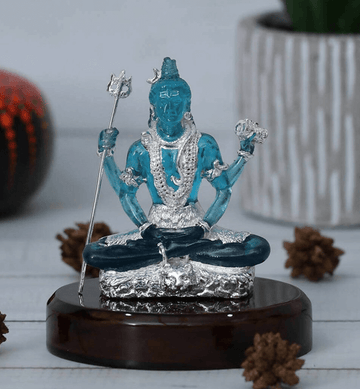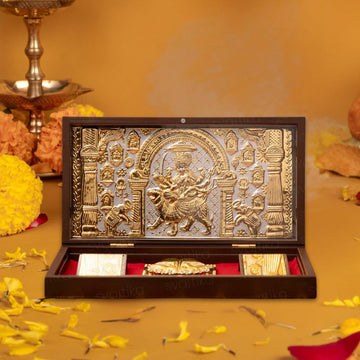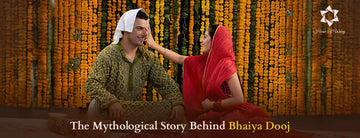Your home is your first temple, the space where your heart bows, and the divine energy arises.
Think of a still place in your house. You can sense calmness, sacred chants swirl, incense wafts around, and diyas twinkle like golden stars. This is not decoration. This is pure devotion.
Within the Hindu tradition, creating a sacred space is not unrelated to excessive decoration; rather, it is about the intention to invite the divine into your everyday life, through your gestures of simplicity and love.
As the Bhagavad Gita (9.26) tells us:
"If one offers Me with love and devotion a leaf, a flower, a fruit, or water, I will accept it."
This is a truth in pooja; it is not about what you are offering, but how you are offering it. Whether it is just one diya or an elaborate rangoli, your devotion is the real decoration.
Let's discuss our intentions and how to express them to achieve something that reflects the tradition.
Why Pooja Decoration Matters in Hindu Worship
Pooja isn't a chore. It's a personal relationship with God. When you create a sacred space in your home, you are creating an experience that draws spiritual energy to you and welcomes peace into your life.
Here is why a few intentional pooja decorations in Hindu worship are important:
- They enhance focus in prayer and meditation.
- They help align your home energy to positivity and protection.
- They create a habit of focus, gratitude, and intention every day.
Your mandir becomes not just a destination for you to go to, but a place you want to keep visiting.
Identifying Your Sacred Corner: The Start of Your Devotion
You don't need a large area, just a sacred corner for a home temple with a large heart. The Vastu for pooja room suggests that the Northeast direction (Ishanya) is auspicious as this corner absorbs and channels divine atmosphere at home.
Here's how you can attract a divine atmosphere at home:
- Select a clean and quiet location, free from distractions
- Find a height for your mandir on a wooden plank or marble base
- Use soft, warm colours like white, yellow, or cream that are in harmony.
-
Do not place the mandir close to toilets or under staircases.
Once you pick a space, treat it like your personal sanctum, your spiritual corner.
Essential Elements for a Divine Pooja Setup
Setting up a pooja room is a mix of tradition and instinct. There are no absolute rules to follow, just intentions that speak to your heart.
What do we need for a sacred mandir?
- Deity idols or photos - preferably in brass, clay, or stone.
- Kalash, containing water, mango leaves, and coconut, symbolizes life, abundance, and purity.
- Puja thali decoration consists of diya, agarbatti, kumkum, chandan, and rice.
- A bell or conch, to wake up energy and help vanish negative energy.
When every piece is placed and assembled with intentionality, your home will turn into a sacred haven, and the pooja experience will be beyond your imagination.
Incorporating Nature in Pooja
Nature is deeply rooted in the foundation of Indian spirituality. Flowers explode with fresh fragrance, rangoli spills with colour, and toran protects and brings grace.
You must incorporate these things in your pooja essentials :
- Fresh garlands of marigolds or jasmine daily, or at least for festivals.
- Patterns for rangoli and pooja setup made from rice flour, petals, or organic colours.
-
Torans made of mango leaves, beads, and/or handmade fabrics would give a divine touch.
These natural elements are not just beautiful; they also provide spiritual energy.
Light & Fragrance: Creating the Mood of Devotion
Just lighting a diya or burning an incense stick can change the energy of the space. Light and fragrance are a quietly powerful mood of peace, they help settle your mind, your breath, and your heart.
To create this space full of energy :
- Use brass or clay diyas filled with ghee or oil.
- Burn natural incense or dhoop in sandalwood, rose
- Light scented candles on evenings and festivals to create a softer light.
This is how you bring both lighting and flowers for pooja to do what words sometimes cannot settle the soul.
Theme ideas for decorating the Mandir for Festivals
Festivals are the times when your mandir springs to life, radiating happiness, colours, and devotion. Each one has its mood and message.
Here are a few Pooja Decoration Ideas At Home that symbolize that:
- Diwali: use fairy lights, gold cloth, and lotus decoration.
- Navratri: create a colourful Golu with figures displayed in layers.
- Ganesh Chaturthi: Utilize sustainably sourced idols with decoration of banana leaves and vibrant stones to elevate.
- Krishna Janmashtami: blues backdrop, flute symbol, and peacock feathers.
These themes help you decorate the mandir at home in the divine rhythm of the festival and reflect its divine energy.
Eco-Friendly and Minimalist Pooja Decoration Tips for Spiritual Home Vibes
You do not need fancy; you need an eco-friendly or minimalist pooja room tied to the idea that it can be sacred.
Ways to Go Green:
- Use upcycled materials; for instance, coconut shells or old brassware.
- Omit plastic flowers; instead, use dried floral garlands or fresh petals.
- Use organic fabric like cotton or linen for altar covers.
- The decor should be minimal; every item should have a purpose and evoke emotion.
These eco-friendly home pooja decoration ideas are gentle on the Earth and generous in spirit.
Colour Combinations To Enhance Spiritual Ambience
Colour is more than appearance; it is feeling. Some colours elevate vibrations, some calm the heart.
Try these spiritual colour combinations to calm your pooja room space:
- White and Gold: purity, peace, connection.
- Red and Yellow: power, joy, and the sacred fire energy.
- Green and Silver: balance, healing, and abundance.
Add them into decorative items for home temples, altar cloths, and diyas, and have a unified energy flow.
DIY Decor Items for your Pooja Room
The most divine touch is the one you create yourself. DIY traditional pooja decor ideas to infuse your sacred space with personal energy.
Here are ideas you can try:
- Paint your diyas with sacred symbols.
- Stitch small mats or crochet covers for the altar.
- Handcraft torans out of flowers, thread, or natural beads.
These aren't merely crafts - they are love, expressed for God in colour and shape.
Scared materials in Pooja Decoration & what They Symbolize

How to make the pooja space divine by keeping it clean?
Sacred places do not remain divine without proper cleanliness. Just as we purify ourselves before prayer, we need to cleanse our pooja space to enhance and keep its energy.
Daily Pooja room setup tips to keep clean & divine:
- Wipe down the altar and idols using a clean cloth or rose water.
- Replace flowers and incense daily.
- Do not store pooja items together with your household items.
This is how you sustain recommendations for a spiritual home energy that stays close to you, like blessings.
Final Take
“Na karmana na prajaya dhanena tyagenaike amrutatva aansu," which means Not by action, nor by progeny, nor by wealth, but by renunciation alone is immortality attained.
Your home does not need to be magnificent to be divine; it just needs spirit. Your pooja room, your diya, your rangoli, these are all indicators of your inner journey. Every flower you lay down, every flame you bring to life, each time you do this, know that your pure heart is the offering.
At Wemy, we believe that all homes can provide shelter. We are asking them to shelter the divine, thus becoming a place to heal and honor the divine, and fill the space with spiritual energy. Start with intention, embellish with devotion, and it will transform into a sacred space of serenity and peace.
Let your home be a Host where the Divine Energy Attracts.










